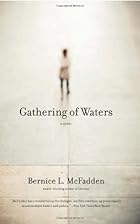 Sometimes a book that you are reluctant to read turns out to be a real surprise. Always reading the same type of book gives you a happy sense of familiarity but it doesn't stretch your reading assumptions in any way. Bernice McFadden's Gathering of Waters is definitely a different book than my usual reads and it pushed me in ways that things that are immediately appealing to me don't always do.
Sometimes a book that you are reluctant to read turns out to be a real surprise. Always reading the same type of book gives you a happy sense of familiarity but it doesn't stretch your reading assumptions in any way. Bernice McFadden's Gathering of Waters is definitely a different book than my usual reads and it pushed me in ways that things that are immediately appealing to me don't always do.Narrated by the town of Money, Mississippi, the town where Emmett Till was murdered, this novel purports to tell the stories of people and place that led up to that terrible, nation changing event and the stories of those left broken in the wake of the tragedy. Opening with an explanation of the concept of animism, the idea that everything in this world is inhabited by souls, some benevolent and others malevolent, which move on to other bodies, animate and inanimate, when their shells die or are destroyed, the novel draws a straight line through characters, material things, and events predicated on this belief. Then introducing the family around whose lives the narrative swirls, the town recedes into the generational story of the Hilson family and starts its march to the tragedy of Emmett Till's short life and on far past it to the arrival of Hurricane Katrina.
This is a quick and compelling read that swirls with questions of inborn goodness and evil and of fate threaded through with a history of racial tension and civil rights. Although the cover blurb focuses on the murder of Emmett Till, the novel is much more expansive than just this single event which, in fact, doesn't occur until quite late in the novel. The narration of the town of Money didn't totally work, not least because allowing Money to continue the tale in Chicago thanks to the potted flower that Tass takes with her was a stretch, although the continued narration of Tass' life up north was certainly necessary to the plot. But over all, this not easily categorized novel was gripping and rich.
Thanks to the publisher for sending me a copy of the book for review.


No comments:
Post a Comment
I have had to disable the anonymous comment option to cut down on the spam and I apologize to those of you for whom this makes commenting a chore. I hope you'll still opt to leave me your thoughts. I love to hear what you think, especially so I know I'm not just whistling into the wind here at my computer.